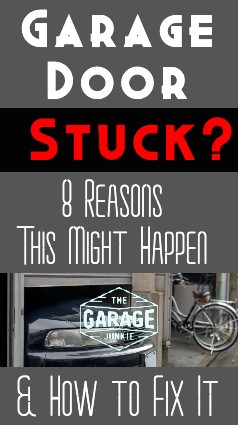There are few sounds more troubling when you are getting ready to leave for work than the snap and reel of a garage spring snapping. This happened a few years back to me, and my panicked thinking immediately went to, “Will I be stuck here forever?!” It took me a couple of minutes to come to my senses after that initial noise and shock, but then my thoughts moved to, “Is my garage door stuck?”, and ” . . . Now what?”
Visions of me maniacally driving my car through the stuck garage door as I sped away put a grin on my face, but I knew my wife would disapprove. So, I did what any responsible husband would do – I pulled the safety latch and got the cars out of the garage the boring way… Then I called a local garage door repair company and the spring was fixed the next day.
In my situation, the garage door was still functional. I just had to lift the door while my wife backed the cars out of the garage. Sadly, this is not always the case. You might find yourself in a situation where the door is completely jammed and truly stuck closed or open. Here are a few things that you may want to check out if you find yourself on the wrong side of a stuck garage door.
Is your garage door stuck? There are several reasons why your garage door may be stuck open or closed. The garage door might be locked, or the tracks may need lubricant. There could be a problem with the garage door sensor, or there could be weather–related concern keeping the garage door stuck in place. Something more severe could also be wrong – the door may be jammed or have an obstruction on the track, or the lift spring could be broken, or a pulley might be jammed. Lastly, the door might be completely off the track or there may be damage causing the garage door to stick on the track. Some of these problems are easy to fix and others might require a professional to step in and assist.

Garage Door Locked
One of the best situations you can run into when your garage door is stuck is that the garage door is simply locked. Some garages will have a manual lock along the track. Others might have a lock that is a part of the wired remote which disables the garage door opener from raising or lowering.
For the manual lock, there are two types that you really need to look at. The first is simply a sliding bolt on the garage door track, normally found on the lower half of the garage door. Generally, you need to just pull the sliding bolt back from the track to disengage the lock, allowing the garage door to raise and lower like normal.
The second lock generally found on the garage doors are ones with a T handle in the front of the door. The T handle lock, when engaged, slightly extends two sliding arms which slide through either side of the garage door frame. These locks prevent the garage door from opening. If you have one of these, and you find your garage door stuck, look to make sure the lock was not engaged keeping the garage door from opening.
Some wired remotes also have a locking mechanism as a part of the unit. Check to see if you have a lock on your wired remote. If you do, it usually has two icons, one being a locked lock and the other being an open lock. Make sure the dial, or switch, is on the open lock so that the garage door opener can function properly.
Lack of Garage Door Track Lubricant
There are a lot of moving parts when it comes to a garage door being able to open and close. If you find your garage door stuck, one of the easy things to check before you call in reinforcements, (I.e. a professional), is to see if your garage door tracks, springs, rollers, hinges, and locks need lubricant.
This is one of those general maintenance things that you should see coming well before it gets too bad. If your garage sounds like cats fighting when it opens and closes, then you know it is only a matter of time before that metal on metal is going to seize and cause issues.
Make sure NOT to use your typical WD-40 here! You will need a lubricant made for the moving parts of your garage. We suggest this other product made by WD-40 that is better suited for your garage door, WD-40 Specialist Protective White Lithium Grease Spray.
Problem with the Garage Door Sensor
Generally, if you have an issue with the garage door sensor, the garage door opener is blinking at you with the garage door stuck open. Most of the time this means that there is some object blocking the sensor. For me, I can nearly guarantee every time that it is my daughter’s big wheel. If there is something blocking the sensor beam, simply move the object and try to close the garage door again.
It would be nice if life’s problems were always so simple. If you do not have an obstruction, but the garage is still not opening or closing due to the garage door sensors, there are other things you might want to investigate to see why the garage door is stuck. If this is the case, if you are not seeing any other viable culprit, look to make sure the sensors are facing correctly.
The garage door sensors fire a beam to each other, and that beam needs to be uninterrupted. If one of the sensors is off-kilter, you will find your garage door stuck since the safety mechanism is keeping it from opening or closing.
One last situation, and simple solution, you might find yourself in with your garage door stuck and your garage door sensors looking to be the culprit has to do with positioning. If sunlight is shining directly at the sensor, the sunlight might overload the sensor and not allow the garage door to lower.
Garage Door Stuck Due to Ice and Snow
Weather can also be the cause of a stuck garage door. Generally, this comes in the form of ice buildup which keeps the door from being lifted. This can damage the bottom seal and lift spring, so if you do find your garage door stuck, do not keep clicking the opener trying to force it. Here are a few other options to assist with this problem and prevent damage to the seal and lift spring.
First, if you have a heatgun or a hairdryer, you can melt some of the direct ice. This will release the seal from the ground and will allow the garage door to raise. If you are using a heatgun, make sure not to damage the paint or anything by getting too aggressive with the ice melting.
Second, you can use an ice scraper to break up some of the ice that is holding the garage door to the ground. Breaking some of the ice will lessen how much surface area is holding the garage door down, making it easier for the garage door opener to lift. Be careful with the bottom door seal, you can damage it if not careful with the scraper.
Lastly, if you find your garage door stuck due to weather, use salt. Being from Michigan, I have seen my fair share of odd things happening due to weather. If you have a bag of salt, sprinkle it along the garage door. If you find yourself ill-prepared for the season, use table salt. The salt lowers the freezing temperature of the ice causing it to melt and allows your garage door to work properly.
To prevent this in the future, determine if the area around your garage door is susceptible to water buildup. You will want to install a drain for that water to run elsewhere. For the short-term, raise your garage door a tiny bit so that the door is not sitting in the water/snow/ice so that it cannot freeze the door to the ground.
Obstructed or Jammed Garage Door Track
Your garage door may be stuck or jammed because the track is obstructed. Take a look to see if something fell into the track that is not allowing the door to be raised or lowered. For example, this could be a kid’s toy or a broom handle. If there is an obstruction, raise or lower the garage door depending on what position it was previously in before the obstruction occurred. Remove the obstruction and then try again.
Broken Garage Door Spring or Jammed Pulley
Most might think that the garage door opener is what is lifting and lowering the door, and in part that might be true. The torsion spring is really the hero of the story when it comes to your garage door functioning properly. The spring is what is doing most of the heavy lifting.
Before going any further on this topic, these torsion springs can be very dangerous. They are difficult to replace without the proper tools and knowhow. Call in a professional if you suspect your torsion spring to be broken.
Most garage door systems will have one or two torsion springs. When one snaps, it will sound like a firecracker. If you hear this happen or notice the garage door opener struggling, do not continually try to open the garage door. The garage door opener was not designed to raise and lower that much weight on its own.
If this happens, but you still need to get the cars out, you are not stuck. You will need two people for this, but you can release the emergency release for the garage door (red cord hanging from the chain track). Pull the emergency release and lift the garage door. I will suggest you have someone hold the door, so it does not come crashing down causing damage to a car or the garage door itself.
Garage Door is Off Track
If you find your garage door stuck and the door itself looks off track, this is going to be something a professional will need to handle. Normally, this will be very apparent. But if it isn’t, look to see if the track wheels, that are connected to the garage door, are within the garage door track.
Do not try to raise or lower if you notice this. The track wheels are what keep the garage door upright and are what helps it suspend when the door is up. The door might give way and fall, causing potential harm and can damage the door causing you a full garage door replacement rather than a garage door track repair.
Damaged Garage Door Track
This also might be obvious, but it needs to be mentioned. Make sure the garage door track does not have any dents or bends. If something is slightly dented, you might be able to fix the bend yourself. For anything more extreme, a professional will need to be called to either repair or replace the garage door track.
It can be nerve-racking when something interrupts the flow of your morning, but hopefully listing some of these “why’s” behind the frustration can take the guesswork out of what to do next.
Thanks for reading, and as always, be sure to keep it tuned to The Garage Junkie for all of your garage’s FYI and DIY needs!
